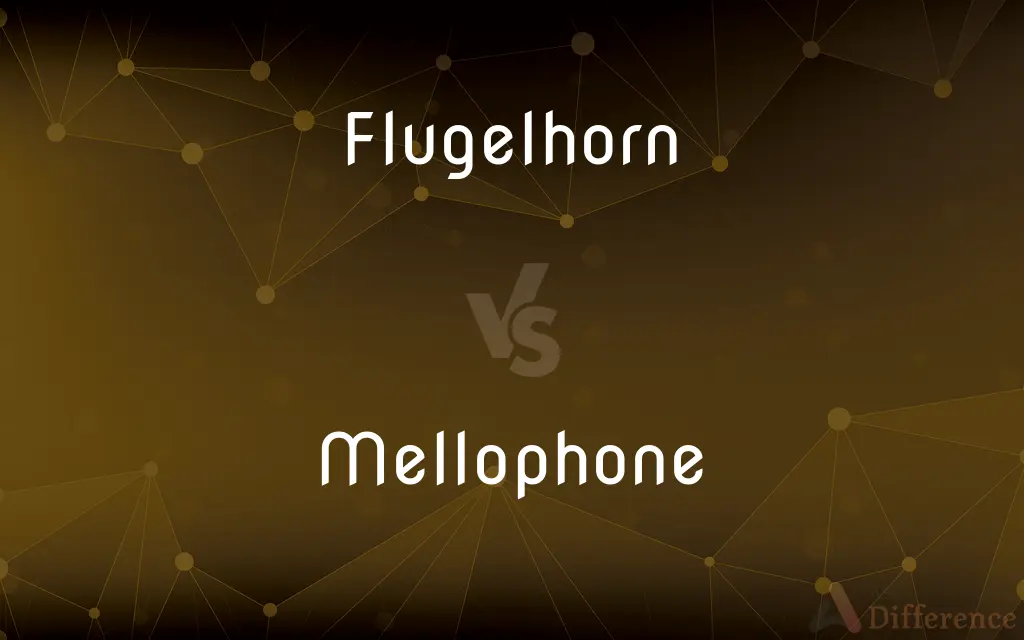Flugelhorn vs. Mellophone — What's the Difference?
By Tayyaba Rehman & Fiza Rafique — Updated on April 26, 2024
The flugelhorn produces a warm, dark sound suitable for jazz and brass bands, while the mellophone offers a brighter tone, often used in marching bands.

Difference Between Flugelhorn and Mellophone
Table of Contents
ADVERTISEMENT
Key Differences
The flugelhorn is a brass instrument closely related to the trumpet but with a wider, conical bore that gives it a softer, mellower sound. On the other hand, the mellophone, also a brass instrument, has a design and playing style adapted for marching bands, providing a sound that projects well outdoors.
Flugelhorns use a deeper mouthpiece than trumpets, which contributes to their distinctive warm and dark timbre. Whereas the mellophone uses a mouthpiece more akin to that of a trumpet or French horn, facilitating easier transitions for players of these instruments in a marching band setting.
The flugelhorn is typically pitched in B♭, similar to the trumpet but it plays an octave lower, offering a lush sound that blends well in jazz and ballads. In contrast, mellophones are usually pitched in F or sometimes in E♭, making them better suited to replace French horns in marching bands due to their forward-facing bell.
Players of the flugelhorn often employ it in jazz, brass band, and orchestral settings where its soft, flowing sound complements other instruments. On the other hand, mellophone players typically perform in marching bands and drum corps, where the instrument's clearer, more penetrating sound cuts through open-air environments.
The flugelhorn and the mellophone both serve as harmonic support within their respective ensembles, but the flugelhorn is particularly valued for its vocal-like quality in soft passages. Meanwhile, the mellophone is prized for its ability to carry melody over a band’s full dynamic range, particularly in outdoor performances.
ADVERTISEMENT
Comparison Chart
Primary Use
Jazz, brass bands, orchestral music
Marching bands, outdoor performances
Sound Characteristic
Warm, dark, lush
Bright, clear, projecting
Pitch
Typically in B♭
Commonly in F or E♭
Mouthpiece
Deep, similar to a cornet
Similar to trumpet or French horn
Bell Orientation
Facing upwards
Facing forwards
Compare with Definitions
Flugelhorn
A brass instrument resembling a trumpet but with a wider, conical bore.
He played a haunting melody on the flugelhorn during the jazz band's final set.
Mellophone
A brass instrument used primarily in marching bands for its forward-facing bell.
The mellophone section marched in tight formation, their notes bright against the drums.
Flugelhorn
Known for its deep, mellow sound, often used in jazz and orchestral music.
The flugelhorn's mellow tones perfectly complemented the smooth saxophone.
Mellophone
Uses a mouthpiece similar to that of a trumpet, aiding players in producing a bright tone.
The bright tone of his mellophone carried well, even at the back of the stadium.
Flugelhorn
Typically equipped with three valves and pitched in B♭.
The flugelhorn player practiced scales to master the instrument's range.
Mellophone
Typically pitched in F or E♭ to blend with other brass instruments.
She tuned her mellophone carefully before the parade began.
Flugelhorn
Often played in settings where a soft, lyrical sound is desired.
The flugelhorn solo added a rich, lyrical quality to the evening's performance.
Mellophone
Features a design that facilitates sound projection in open-air environments.
His mellophone solo soared over the crowd, clear and commanding.
Flugelhorn
Features a deep mouthpiece which enhances its warm sound quality.
Adjusting his grip, he prepared to play the flugelhorn's complex passage.
Mellophone
Often serves as a replacement for the French horn in marching settings.
Transitioning from French horn to mellophone, she adapted quickly to the new fingering.
Flugelhorn
The flugelhorn (), also spelled fluegelhorn, flugel horn, or flügelhorn, is a brass instrument that resembles the trumpet and cornet but has a wider, more conical bore. Like trumpets and cornets, most flugelhorns are pitched in B♭ (some are in C).
Mellophone
The mellophone is a brass instrument typically pitched in the key of F, though models in B♭, E♭, C, and G (as a bugle) have also historically existed. It has a conical bore, like that of the euphonium and flugelhorn.
Flugelhorn
A bugle with valves, similar to the cornet but having a wider bore.
Mellophone
A brass wind instrument, similar to the French horn, often used in military or marching bands.
Flugelhorn
A brass instrument resembling a cornet but with a wider, conical bore, and usually with three valves, in the same B-flat pitch as many trumpets and cornets but with a more deeply conical mouthpiece than those. A bugle with valves.
Mellophone
A brass instrument frequently used in place of the French horn in marching bands and similar performance groups
Flugelhorn
A brass wind instrument resembling a cornet but with a wider bore, and having three valves.
Flugelhorn
A brass instrument resembling a cornet but with a wider bore
Common Curiosities
What type of music is the flugelhorn best suited for?
The flugelhorn is best suited for jazz, brass bands, and orchestral music where a soft, lyrical sound is desired.
How does the sound of a mellophone differ from a French horn?
The mellophone has a brighter, clearer sound compared to the French horn's deeper, more mellow tone.
What is the typical pitch range of a flugelhorn?
The flugelhorn is typically pitched in B♭.
Why is the mellophone preferred in marching bands?
Its forward-facing bell and brighter tone make it more effective in outdoor, dynamic environments typical of marching bands.
Is the mellophone difficult to play for someone with experience on the trumpet?
The mellophone can be easier for trumpet players due to the similar mouthpiece and playing technique.
What accessories are commonly used with the mellophone?
Common accessories include various sizes of mouthpieces and carrying cases designed for the rigors of marching.
Can the mellophone be used in an orchestral setting?
While primarily designed for marching bands, the mellophone can be adapted for orchestral use, especially in pieces that require a bright, projecting sound.
How does the flugelhorn's sound blend in an orchestra?
The flugelhorn blends well in orchestral settings, especially in softer, more lyrical sections.
What maintenance does a mellophone require?
Regular cleaning, oiling of valves, and slide greasing are necessary for maintaining a mellophone.
What skills are required to master the flugelhorn?
Mastery of the flugelhorn requires skill in breath control, valve operation, and a good ear for its subtle sound nuances.
What is the role of the flugelhorn in a jazz ensemble?
In a jazz ensemble, the flugelhorn often plays melodic and harmonic parts, utilizing its warm, soft timbre to blend smoothly with other instruments.
How does the construction of a flugelhorn influence its sound?
The wider, conical bore and deep mouthpiece of the flugelhorn create a warmer, softer sound.
Can a trumpet player easily switch to playing the flugelhorn?
Yes, many trumpet players can switch to the flugelhorn without much difficulty due to the similarities in playing technique.
Are there different types of mellophones based on key?
Yes, mellophones can be found in different keys, typically F or E♭.
What type of mouthpiece is used with a flugelhorn?
A deep, funnel-shaped mouthpiece is typically used to enhance the flugelhorn's warm sound.
Share Your Discovery

Previous Comparison
Callee vs. Caller
Next Comparison
Bobsleigh vs. TobogganingAuthor Spotlight
Written by
Tayyaba RehmanTayyaba Rehman is a distinguished writer, currently serving as a primary contributor to askdifference.com. As a researcher in semantics and etymology, Tayyaba's passion for the complexity of languages and their distinctions has found a perfect home on the platform. Tayyaba delves into the intricacies of language, distinguishing between commonly confused words and phrases, thereby providing clarity for readers worldwide.
Co-written by
Fiza RafiqueFiza Rafique is a skilled content writer at AskDifference.com, where she meticulously refines and enhances written pieces. Drawing from her vast editorial expertise, Fiza ensures clarity, accuracy, and precision in every article. Passionate about language, she continually seeks to elevate the quality of content for readers worldwide.















































